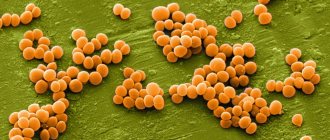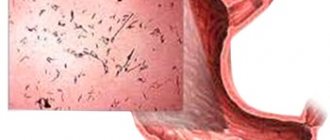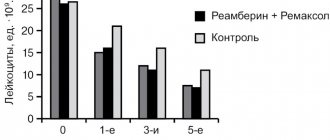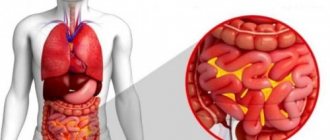Properties of the pathogen
Staphylococcus in the intestines
Staphylococci are a family of bacteria that differ in their properties. The most dangerous and contagious is Staphylococcus aureus, which causes diseases of various organs and tissues.
Illness associated with this pathogen can range from mild and requiring no treatment to severe and potentially fatal.
Staphylococci are gram-positive bacteria, which is due to the properties of their cell wall. Bacteria can perform their functions in environments with oxygen and without access to oxygen. In this case, Staphylococcus aureus can cause the following pathologies:
- Minor skin infections:
- Furunculosis, folliculitis and carbuncles.
- Abscesses.
- Lung infections, including pneumonia.
- Infections of the brain and its membranes.
- Intestinal infections and poisoning.
- Bone infections, in particular osteomyelitis.
- Heart infections, endocarditis.
- Systemic infections and blood poisoning.
Staphylococcus aureus can live on the human body and not cause disease. This bacterium can be found in the nasal cavity, on the skin, and in the genital area. For the disease to occur, additional pathological factors are required, in particular weakening of the immune system.
When favorable factors appear in the bacterium, invasion factors are activated, due to which the body tries to overcome natural barriers and enter the internal environment.
The following categories of patients are most susceptible to staphylococcal infections:
Types of pathogenic staphylococci
Several types of bacteria are dangerous to humans. The most common:
- Staphylococcus aureus: golden. It got its name because of the characteristic yellow pigment on the surface. Penetrating into the body, it synthesizes the enzyme coagulase and can cause purulent inflammation of almost any internal organs. This type of pathogen quickly adapts to the effects of antibiotics, forming resistant forms.
- Staphylococcus epidermidis: epidermal. It usually affects the skin and mucous membranes. It often becomes a factor in inflammation of injuries, postoperative sutures, the development of purulent conjunctivitis, and respiratory tract infections.
- Staphylococcus saprophyticus: saprophytic. Its specificity: affects the mucous membranes of the urinary organs, provokes cystitis, urethritis, and kidney inflammation.
- Staphylococcus haemolyticus: hemolytic. Dangerous for mucous membranes and tissues of internal organs. It becomes a provocateur of the development of endocarditis, pneumonia, nephritis and other severe pathologies.
Almost all types of pathogenic staphylococci are prone to mutations as a result of improper or insufficiently long treatment.
Intestinal diseases
Taking a smear for staphylococcus
Staphylococcus aureus often causes intestinal inflammation. The appearance of such a pathology may be associated with food poisoning or other factors. The disease is called bacterial gastroenteritis.
The effect of bacteria on the intestinal wall can cause fluid retention and interfere with the absorption of nutrients. The patient often experiences acute symptoms, including fever, vomiting, severe abdominal cramps, and diarrhea.
The course of bacterial gastroenteritis can range from mild to very severe. There is always a risk of acute loss of body fluids, which is usually associated with vomiting and diarrhea. This disease can be observed against the background of an improper diet, malabsorption syndrome and other pathologies.
The disease often resolves on its own, but improper treatment of the acute form of the infection can lead to the development of a chronic process. It is also important to stay hydrated, as dehydration can be fatal.
Bacterial gastroenteritis can be the result of poor hygiene. Infection can occur after close contact with animals or consumption of food contaminated with bacteria.
Causes of infection and treatment
The cause of infection can be not only damage to the skin or consumption of contaminated food, but also contact with an infected person - staphylococcus can be transmitted by airborne droplets, through dishes, cutlery, and towels.
Infection can occur in hospitals, surgical wards, and intensive care units. The source of infection can be inflatable tubes, catheters and medical equipment, the use of which required disruption of tissue integrity.
Treatment of Staphylococcus aureus is difficult and requires the use of an appropriate antibiotic. The cure time for staphylococcus depends on whether the strain is resistant to methicillin.
Symptoms
Bacterial gastroenteritis is a fairly aggressive disease characterized by acute symptoms. Violations of intestinal functions make themselves felt already on the first day of the development of the disease. The following symptoms may appear:
- Nausea and profuse vomiting.
- Prolonged diarrhea.
- Cramping abdominal pain and abdominal muscle cramps.
- Presence of blood in the stool.
- Fever.
- Dizziness and impaired consciousness.
- Weakness and loss of appetite.
- Headache.
- Reduced blood pressure.
The appearance of fever and abnormal blood pressure may require urgent hospitalization. The most dangerous symptoms of bacterial gastroenteritis are associated with dehydration, which can cause death in the patient. In addition, you should consult a doctor if symptoms do not go away within five days.
How does a staphylococcal infection manifest?
Symptoms, its duration and intensity depend on the strain of the pathogen, the general physical condition of the patient and the characteristics of his immunity. Two characteristic signs of staphylococcal damage: inflammation of various localizations and intoxication.
With pyoderma, the sweat, sebaceous glands, and hair follicles become inflamed, causing painful convex nodules that fill with pus to form on the skin. Boils and carbuncles are usually surrounded by areas of red, swollen skin. With intense inflammation, fever and swelling of the lymph nodes located close to the sites of inflammation are likely.
Infection of the nasal sinuses by staphylococcus is manifested by a common runny nose with viscous yellowish or green discharge. Penetration of infection deeper causes the development of sinusitis. Their symptoms are typical:
- congestion in the bridge of the nose;
- feeling of heaviness, fullness on the affected side;
- labored breathing;
- thick purulent discharge from the nose;
- increase in body temperature above +37°C.
Often the infection spreads to the middle ear, causing otitis media: sharp shooting pains, hearing loss. When the mucous membranes of the eyes are damaged, suppuration of the conjunctiva develops, the sclera turns red and swells.
When staphylococcus attacks the upper respiratory tract, purulent pharyngitis or laryngitis is inevitable. Their signs:
- hoarse voice;
- severe swelling, redness of the throat;
- difficult painful swallowing;
- dry obsessive cough, discomfort in the throat.
Staphylococcal pharyngitis often affects children under 12 years of age. In adults, this pathology is controlled by the immune system.
With the development of inflammation in the lower parts of the respiratory tract, bronchitis and pneumonia are “relevant” with a characteristic barking or wet cough, high fever and physical weakness.
Less common signs of staphylococcus infections:
- food poisoning;
- inflammation of joint tissues, muscles;
- cardiac dysfunction.
Among the serious complications caused by staphylococcus are: meningitis, lung abscesses, osteomyelitis, toxic shock syndrome, generalized sepsis.
Diagnostics
As a rule, cases of bacterial gastroenteritis are easily recognized due to characteristic clinical manifestations. Differential diagnostic methods may be needed to determine the exact type of bacteria and rule out other diseases.
The doctor conducts a general examination of the patient, identifying characteristic symptoms and complaints. The condition of dehydration is detected at this stage of diagnosis. The doctor will also ask the patient about the foods he has recently consumed, since Staphylococcus aureus often contaminates sweet foods.
Other tests:
- Laboratory studies of feces and vomit. Includes checking for the presence of blood cells and identifying bacteria. It may also be necessary to determine the acid-base properties of the discharge.
- Isolation of bacterial culture.
- Blood analysis.
Bacterial gastroenteritis in most cases is diagnosed immediately when the patient is examined in the doctor's office. Laboratory diagnostics help clarify the patient’s condition.
How dangerous is staphylococcus in infants?
In the absence of adequate antibacterial therapy, staphylococcal infection leads to many severe and deadly complications:
- Development of dehydration. Prolonged and painful diarrhea, as well as frequent vomiting, lead to the fact that water along with electrolyte salts is removed from the body at tremendous speed. The body is not able to bring all systems into a state of dynamic equilibrium (homeostasis). As a result, shock may develop and death may occur. In children, dehydration begins much earlier due to less fluid in the body;
- Infectious-toxic shock. Staphylococcus aureus is one of the leaders in reproduction speed. As mentioned, the bacterium produces many toxic substances. With excessive proliferation of toxins and enzymes there are so many that the body loses the ability to maintain all necessary vital functions: the kidneys, heart, liver and brain fail;
- Intestinal bleeding. Long-term enterocolitis leads to destruction of the intestinal epithelium, perforation of its walls and massive bleeding;
- Peritonitis. With perforation of the walls, food and feces leave the intestine, infecting the abdominal cavity;
- Sepsis. By destroying the intestinal walls, staphylococcus can penetrate the bloodstream. This will lead to blood poisoning, and the risk of death will increase many times;
- Development of carriage of Staphylococcus aureus. Even if treatment is carried out timely and effectively, there is a risk of developing carriage of the bacterium. The microorganism begins to exist in a latent form. Clinically, carriage resembles a sluggish dysbacteriosis: decreased appetite, stool instability, diarrhea alternating with constipation and periods of normal bowel function, heaviness in the abdomen, bloating, flatulence (colic), frequent regurgitation.
Over time, either staphylococcus is reactivated, or the child’s immune system, together with bifidumbacteria, will “pacify” the pathogen.
Treatment of staphylococcus in infants
Therapy for staphylococcus infections comes down to three main aspects:
- Establishing control over the intensity of microorganism reproduction, destroying pathogens using the method of sanitation and taking bacteriophages;
- Maintenance treatment (restoration of water balance in the body, prescription of therapeutic nutrition);
- Treating infants with antibiotics is absolutely unacceptable. Antibacterial therapy using macrolides or cephalosporins is advisable only in children with confirmed sepsis.
In all other cases, antibiotics destroy the intestinal microflora, and staphylococcus safely continues to exist and enterocolitis flares up even more strongly, since the pathogenic flora no longer experiences competition from bifidum and lactobacilli.
Probiotics do not help in this case, since while taking antibiotics, the beneficial flora does not take root, and staphylococci or Klebsiella quickly destroy the incoming insignificant number of beneficial bacteria.
It is most reasonable to carry out treatment with specialized bacteriophages - viruses that devour a specific type of bacteria. Staphylococcus bacteriophage is used in pure form or as a complex (a mixture of phages of Staphylococcus, Salmonella, Shigella, etc.)









